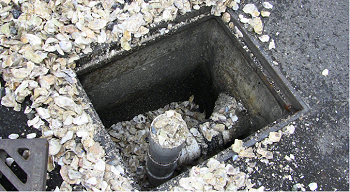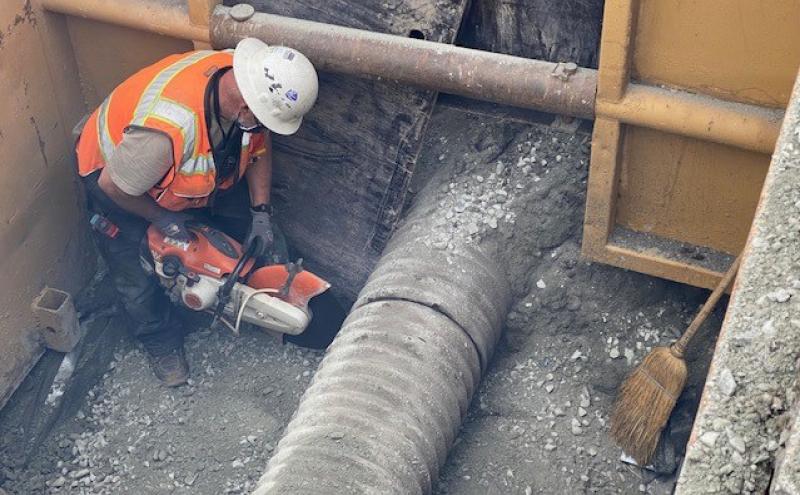
Stormwater is the flow of water generated by precipitation and runoff from land, including pavement, building rooftops, and other hard surfaces. Hard or 'impervious surfaces' do not allow rainfall to absorb into the ground or filter through the soil. Runoff from hard surfaces carries pollutants including oil, grease, metals, and bacteria. Annually, the Maritime Port manages 1.2 billion gallons of stormwater runoff from 1,560 acres of facilities.
The Phase I Municipal Stormwater Permit requires the Port to develop and implement a Stormwater Management Program (SWMP). The Port also publishes an Annual Report as part of the permit requirements.
What Does the Maritime Stormwater Program Cover?
The management of stormwater is a crucial part of the Port's responsibility in protecting the Puget Sound. Covering 1,560 acres, the Maritime Port's paved surfaces are more than 20 times larger than Seattle Center and almost twice the size of New York's famed Central Park. These surfaces require the Maritime Port to manage 1.2 billion gallons of runoff annually.
The Washington State Department of Ecology (Ecology) regulates discharges of stormwater runoff through a permitting process. The Port works closely with state and local agencies and our tenants to minimize the impact of stormwater runoff on local waters and aquatic habitats.
Stormwater Regulatory Overview
The Maritime Port operates under a Phase I National Pollutant Discharge Elimination System (NPDES) General Permit for Municipal Stormwater (Phase I Permit), issued by Ecology under the Federal Clean Water Act. Phase I Permits apply to municipalities with populations of 100,000 or more, and to agencies located within the municipality. The Phase I Permit establishes a framework for controlling pollutants from stormwater runoff to the maximum practical extent. Its goal is restoring and maintaining the chemical, physical and biological integrity of our region's waters including rivers, streams, lakes, wetlands, and marine waters.
Most of the Maritime Port's property is leased to commercial and industrial tenants. Approximately 70 percent of these properties are covered by an NPDES Industrial Stormwater General Permit, which includes additional requirements beyond those in the Phase I Permit.
Learn More About Maritime Division's Phase I Municipal Permit
Stormwater Information
The Maritime Port is a secondary permittee under the NPDES Phase 1 Municipal Stormwater Permit. The Phase I Permit regulates discharges to waters of the state from large and medium storm sewer drainage systems. The Port is regulated under the Phase I Permit because the stormwater system drains to the Ship Canal, Shilshole Bay, Duwamish River, and Elliot Bay. The Port received secondary permit status because it owns and operates its own stormwater system within the City of Seattle.
The Phase I Permit requires the port to develop and implement a Stormwater Management Program (SWMP). The Port's SWMP includes the following components:
- Education Program
- Public Involvement and Participation
- Illicit Discharge Detection and Elimination
- Construction Site Stormwater Runoff Control
- Post Construction Stormwater Management for New Development and Redevelopment
- Operation and Maintenance Program - Operation and Maintenance Manual
- Source Control in Existing Developed Areas
- Total Maximum Daily Load Requirements
- Monitoring and Assessment
- Reporting Requirements
Maritime tenants play a crucial role in protecting water quality in Puget Sound. Any polluting activity has direct effects on the nearshore waters and Puget Sound. The Port is actively working with tenants to improve operations and manage stormwater runoff to protect the natural environment.
Oysters Shells and Stormwater
Oyster shells are being used at the Maritime Port for two purposes, to increase stormwater hardness and remove copper. The hardness of stormwater is very low, as it only contacts impervious surfaces (paved areas). The copper contaminated water is harmful to fish and other aquatic species. Copper is introduced from vehicle brake pads, which produce brake dust containing the metal. Stormwater monitoring sites around high traffic volume areas along the Seattle waterfront can produce elevated levels of copper.
Samples along the Alaskan Way Viaduct were exceeding the Industrial permit benchmark for copper, at 14 parts per billion. The source of copper was discovered to be related to traffic from the Viaduct. Oyster shells have shown promising results for removing dissolved copper from water, so shells were poured directly into stormwater catch basins in the area.
The oyster shells work to filter free copper by absorption. Many factors influence this chemical process, including the level of copper present along with substrate levels of calcium or magnesium carbonate, and the acidity of the water.
More information on oyster shell treatment can be found at Four Ways Oysters Help Protect the Environment, along with instructions to Build Your Own Oyster Shell Barrel Stormwater Treatment System.

Questions? Contact the Maritime Stormwater Team at: [email protected]



